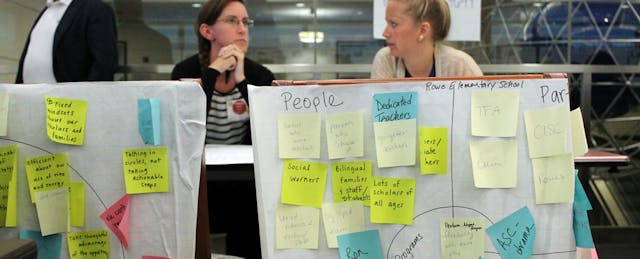When Amy Vreeland took her team to Chicago this July, friends and colleagues offered advice on the best restaurants in the city, must-see attractions, and other recommendations. After all, it’s one of the world’s best cities to visit during Summer.
But most of their time was spent training over 130 educators and school leaders during the Summer Design Program--a series of three, two-day professional development workshops for the Chicago Public School System.
Amy is the Founder and CEO of TrueSchool Studio--a year-old upstart headquartered in New Orleans that uses research and design best practices to help schools around the country impact student outcomes. Her company has a bold theory of change: If schools and school leaders approached their problems like members of the design community, they arrive at solutions in a quicker, more cost-effective, more communal way.
For those new to the term, design thinking is a problem solving methodology used by consultancies like IDEO, suggesting that products and services would be more effective if the designer a) listened to the user, b) quickly and cheaply incorporated their feedback into iterations of the solution, and c) refrained from investing large amounts of resources until the solution is proven to work.
A Chicago Case Study

“Partnering with the Fund on the Summer Design Program was a unique opportunity to enable educators to rethink not only the design of classrooms, but also whole schools and district-wide systems. The educators worked to identify problems they want to solve in their schools and solutions they create and lead.”
During a time when districts and school systems are being forced to do more with less, applying design thinking to new initiatives sounds like a no brainer. But it also poses an interesting risk for today’s school leaders: offering teachers a license to identify and solve problems facing their school could potentially compete for their professional attention and loyalty.
Ben Kutylo, Director of Program Investments at the Chicago Public Education Fund, sees the value in making the short-term investments in their teachers, in hopes for long-term returns for their school, and ultimately for our country.
“Back in 2013, we started the Summer Design Program because we believe public education is changing and that principals and teachers should lead that change,“ commented Kutylo. “Over two years, the program has supported more than 200 educators from 60 schools in designing solutions that personalize teaching and learning, ultimately leading to better schools and student outcomes.”
Kutylo reached out to Vreeland after a 4.0 Schools Essentials workshop in 2013, hoping to infuse new thinking into the one-year program, and selected her company as the lead partner for the 2014 Summer Design Program.

“TrueSchool led the design of the content for the five-week program, while facilitating the workshops, and coordinating support of the school teams and logistics. Moving forward, we are also able to offer schools additional resources and support throughout the year to actually put the ideas into practice. We’ll measure the impact on teaching and learning and better understand what’s effective and what isn’t,” said Kutylo.
And the potential for a broader influence is clear. “Hopefully, our findings will serve to inform the national discussion around innovation in schools.”
What Design Thinking Cultivates
Through a proactive approach, TrueSchool, the Chicago Public Education Fund and their partner schools are taking ownership over how teachers leverage innovation, problem solving, and ultimately, entrepreneurial endeavors. Experiences like Karin Breo’s, the School Director of CICS Irving Park, prove that design thinking can be personally gratifying, making it not just a professional development or problem solving tool, but also a teacher retention tool.
“I think in education, teachers and staff get in a rut in the way they think, making change more difficult,” she reflected. “It was amazing to come back after the program and have such intentional conversations with other staff members about thinking differently and coming up with solutions, but also knowing that it was ok to change your thinking and regroup and try something new.”
Bryan Quinlan, an assistant principal at James Monroe Elementary, described a fourth aspect of design thinking that teachers benefit from. It’s an idea known as “unbundling,” or breaking down a complex problem into simpler, more manageable parts. This exercise encourages teachers to feel empowered to innovate in their classrooms, helping them overcome the initial fear and doubt of tackling problems too large to be addressed by a small group of people.
“We were pushed by one another to really tackle a big problem. We walked away with tangible items because once we pushed ourselves, we started to chip away at this big problem and make our vision a reality we could grasp,” shared Quinlan.
While Chicago may be leading the charge for schools to adopt design thinking, Vreeland believes this is only the beginning. “What’s most exciting for us is seeing the mindset shifts--how people think about their role, and entirely new roles that emerge. This is exciting news for the field of education,” says the founder.


